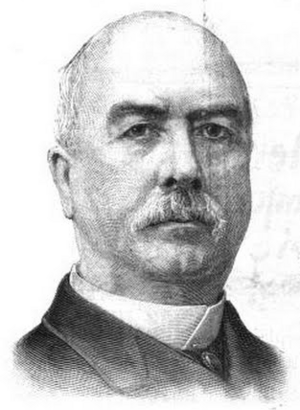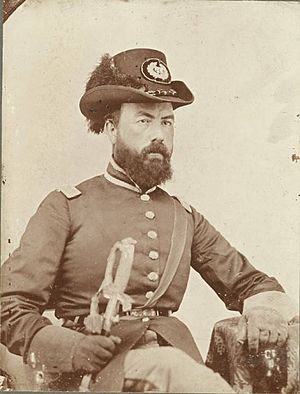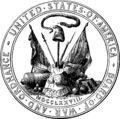Nathaniel H. R. Dawson facts for kids
Quick facts for kids
Nathaniel H. R. Dawson
|
|
|---|---|
 |
|
| 3rd United States Commissioner of Education | |
| In office August 6, 1886 – September 3, 1889 |
|
| President | Grover Cleveland Benjamin Harrison |
| Preceded by | John Eaton |
| Succeeded by | William T. Harris |
| Speaker of the Alabama House of Representatives | |
| In office 1880–1881 |
|
| Personal details | |
| Born |
Nathaniel Henry Rhodes Dawson
February 14, 1829 Charleston, South Carolina |
| Died | February 1, 1895 (aged 65) Selma, Alabama, U.S. |
| Political party | Democratic |
| Spouses |
Anne Eliza Mathews
(m. 1852; Mary Elizabeth Tarver
(m. 1857; Elodie Breck Todd
(m. 1862; |
| Children | 4 |
| Military service | |
| Allegiance | |
| Branch/service | |
| Rank | Colonel |
| Unit | 4th Alabama Infantry |
| Battles/wars | American Civil War |
Nathaniel Henry Rhodes Dawson (born February 14, 1829 – died February 1, 1895) was an American lawyer and politician. He is best known for serving as the 3rd United States Commissioner of Education. This important role meant he was in charge of leading education for the entire country. During the American Civil War, he was a colonel in the Confederate Army.
Contents
Early Life and Family Roots
Nathaniel Dawson was born in Charleston, South Carolina, on February 14, 1829. His father, Lawrence Edwin Dawson, was a lawyer and served in the state legislature. Nathaniel's mother was Mary Wilkinson (née Rhodes) Dawson.
His family had a long history in public service. His paternal grandfather, John Dawson Jr., was once the mayor of Charleston. On his mother's side, his great-grandfather was Paul Hamilton, who had been the Governor of South Carolina and the U.S. Secretary of the Navy during the War of 1812. Nathaniel was also a descendant of Nathaniel Johnson, an early colonial governor of South Carolina.
In 1842, when Nathaniel was about 13, his family moved from Charleston to Dallas County, Alabama. He attended private schools and later went to St. Joseph's College in Mobile, Alabama.
Becoming a Lawyer and Early Politics
After college, Nathaniel Dawson began studying law with his father. When his father passed away in 1849, he continued his studies with Judge George R. Evans. He officially became a lawyer in 1851. Later, he moved to Selma, Alabama, and worked with Edmund Pettus, who would later become a U.S. Senator.
In 1855, Dawson ran for the Alabama legislature as a Democrat, but he did not win. He was also a delegate to the Democratic National Convention in Charleston in 1860. This meeting was very important because it led to a split in the Democratic Party right before the Civil War.
Service During the Civil War
When Alabama left the United States in January 1861, Nathaniel Dawson became a captain of a local military group called the Selma Cadets. This group later became part of the 4th Alabama Infantry. He fought in Virginia during the American Civil War.
From 1863 until the war ended in 1865, he commanded a group of cavalry soldiers. Even while serving in the military, he was elected to the Confederate States Congress in 1863 and 1864. He would serve in the assembly and then return to his military command when the legislative sessions ended.
After the War: Public Service
After the Civil War, Dawson went back to being a lawyer in Selma. He became very active in politics in the South.
He was chosen as a trustee for Alabama's public school system (which later became the University of Alabama) in 1876. He held this position until he died in 1895. He also served on the Democratic Executive Committee of Alabama for ten years.
In 1880, Dawson was elected to the Alabama House of Representatives. His fellow members chose him to be the Speaker of the House from 1880 to 1881. He also ran for governor of Alabama in 1882 and 1886, but he was not successful in winning the nomination.
Leading Education in the U.S.
In August 1886, President Grover Cleveland appointed Nathaniel Dawson as the 3rd United States Commissioner of Education. This was a very important job, overseeing education across the entire country. He took over from John Eaton, who had served under several presidents. Dawson had helped President Cleveland with his election campaign in Alabama in 1884.
In 1887, Columbia College gave Dawson an honorary degree. This was to recognize his great work and help for education. When President Benjamin Harrison took office in 1889, Dawson offered his resignation. He left the position on September 3, 1889, and was replaced by William Torrey Harris.
After leaving the Education Department, Dawson returned to practicing law. In 1892, he was elected to the Alabama House of Representatives for a third time.
Personal Life
Nathaniel Dawson was married three times and had four children. His first wife was Anne Eliza Mathews, whom he married in 1852. They had one daughter, Elizabeth. After Anne's death in 1855, he married Mary Elizabeth Tarver in 1857. They had a daughter named Mary.
After his second wife passed away in 1860, Dawson married Elodie Breck Todd in 1862. Elodie was the daughter of Robert Smith Todd, a merchant and politician. Interestingly, Elodie's older half-sister was Mary Todd Lincoln, who was the wife of U.S. President Abraham Lincoln. Nathaniel and Elodie had two sons: Nathanial Henry Rhodes Dawson Jr. and Lawrence Percy Dawson.
Elodie, his third wife, died in 1877. Nathaniel Dawson passed away at his home in Selma, Alabama, on February 1, 1895. He was buried in Old Live Oak Cemetery in Selma.
Images for kids



